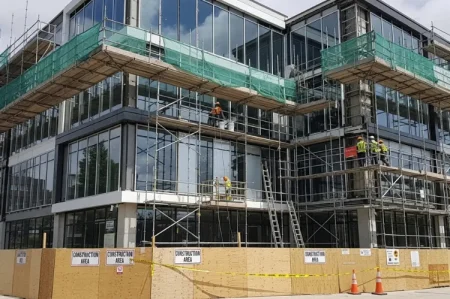Exterior environments are powerful extensions of a home’s character. Thoughtful outdoor lighting and landscape design not only beautify the space but also increase its functional value. The combination of light, greenery, and architectural form enhances visibility, security, and curb appeal. Homeowners who rely on expert services such as local lawn care in Red Lion can achieve well-balanced landscapes that complement lighting installations perfectly. Investing in cohesive outdoor environments often results in measurable increases in property value and long-term buyer appeal. The following guide explores how each design element — from lighting techniques to lawn care — contributes to enduring beauty and value.
How Does Outdoor Lighting Influence Property Value?
Outdoor lighting transforms ordinary spaces into visually compelling settings. It highlights architectural details, defines outdoor living areas, and increases nighttime usability. Beyond aesthetics, lighting systems contribute to energy efficiency, safety, and smart home integration.
Lighting Types
Different lighting types serve unique purposes. Pathway lights illuminate driveways and walking routes. Accent lights emphasize architectural or garden features. Floodlights cover larger areas, while spotlights focus on decorative details. Together, they create layered illumination that enhances both beauty and security.
Fixture Placement
Strategic placement determines the success of any lighting plan. Lights positioned near textured walls reveal material depth, while underlighting trees produces upward drama. Fixtures along steps or ponds improve safety and ambiance. Proper distribution prevents dark patches and maintains visual balance.
Energy Efficiency
Modern outdoor systems rely on LED and solar technology, offering longer lifespan and lower energy use. Energy-efficient lighting not only reduces operational costs but also aligns with sustainability values, which modern homeowners prioritize. These systems often come with minimal maintenance requirements, improving long-term investment appeal.
Smart Control Systems
Integration with smart controls allows automatic scheduling, dimming, and sensor activation. This innovation provides flexibility and energy savings while offering a sense of technological advancement. Motion sensors also contribute to security and reduce unnecessary light pollution.
Maintenance Practices
Consistent upkeep — cleaning lenses, replacing bulbs, and checking connections — preserves light quality and system efficiency. A well-maintained setup ensures reliable operation, sustaining the home’s appeal and maintaining perceived value over time, much like a thoughtfully planned Design a Garage can enhance both functionality and overall property appeal.
Table: Common Outdoor Lighting Elements
| Lighting Type | Purpose | Ideal Location | Estimated Cost (USD) |
|---|---|---|---|
| Pathway Lights | Guide movement and enhance safety | Walkways, driveways | 20–100 per fixture |
| Accent Lights | Highlight features or plants | Garden, façade | 50–150 per unit |
| Floodlights | Cover wide areas | Backyards, corners | 75–200 per fixture |
| Wall Wash Lights | Create soft glow over walls | Façade, patio walls | 60–120 per unit |
| Step Lights | Illuminate stairs | Entrances, decks | 40–80 per fixture |
Why Is Landscape Design Essential for Visual Harmony?
A well-planned landscape integrates plants, hardscapes, and lighting to form a unified aesthetic. It ensures that every outdoor element contributes to the property’s identity and usability.
Garden Layout
The layout establishes visual rhythm and flow. Grouping plants by color and height directs the viewer’s gaze naturally through the space. Pathways and flowerbeds define structure, helping lighting fixtures blend harmoniously.
Hardscape Elements
Patios, stone borders, and decorative walls create permanence and contrast. They provide structure to softer plantings and offer surfaces that reflect light, enhancing visual texture. Quality materials such as natural stone or composite decking add a sense of luxury.
Seasonal Plants
Integrating plants that bloom at different times maintains vibrancy throughout the year. Seasonal variation ensures that lighting interacts with ever-changing foliage, giving the garden a dynamic, living quality.
Color Balance
Balancing warm and cool plant tones creates depth and emotion. Complementary colors produce soothing visuals under warm lighting. This balance ensures that illumination enhances rather than overwhelms the natural hues.
Water Features
Fountains, ponds, and waterfalls contribute sound, movement, and reflection. When illuminated, water surfaces add brilliance and depth to nighttime scenes, turning gardens into tranquil retreats.
Landscape Design Components and Their Roles
| Component | Function | Lighting Integration | Value Contribution |
|---|---|---|---|
| Flower Beds | Add color and shape | Ground-level accent lights | Enhances visual appeal |
| Stone Pathways | Provide structure | Edge or path lighting | Defines layout |
| Trees | Add height and canopy | Up-lighting and spotlights | Creates dramatic visuals |
| Decorative Walls | Separate zones | Wall washing | Adds depth and privacy |
| Water Features | Introduce motion | Underwater or floating lights | Adds luxury appeal |
How Does Lawn Maintenance Complement Outdoor Lighting?
Healthy lawns form the foundation of all exterior design. Vibrant turf reflects light effectively, amplifying brightness and emphasizing contours created by illumination.
Turf Health
Strong turf enhances the natural glow of lighting by reflecting consistent color tones. Proper mowing, aeration, and soil management ensure resilience and even growth.
Irrigation Systems
Automated watering maintains balance between hydration and conservation. Timed systems prevent dry patches and keep grass uniformly green, ensuring even illumination reflection.
Lawn Edging
Defined edges between lawn, walkway, and garden beds create order. Edging also prevents light scattering by keeping boundaries crisp, complementing structured lighting design.
Fertilization
Nutrient-rich soil sustains lush color that complements outdoor lighting hues. Fertilization schedules based on grass type and season support consistent vibrancy.
Weed Control
Weed prevention ensures visual uniformity. Clear, well-maintained lawns enhance the clean light flow across surfaces, reinforcing an impression of precision and care.
What Architectural Features Benefit the Most from Lighting?
Architectural illumination blends design and functionality, turning structural elements into focal points.
Façade Lighting
This emphasizes texture, color, and material details. Up-lighting and wall washing reveal craftsmanship and create evening charm.
Walkway Illumination
Path lights and recessed fixtures along driveways guide visitors safely while showcasing design geometry.
Entryway Design
Lighting at entrances draws attention to doors, arches, and columns, symbolizing hospitality and grandeur.
Patio Ambience
Warm-toned lights in patios create comfort for gatherings. They transform functional spaces into relaxing outdoor living zones.
Fence Accents
Lighting along fences outlines property boundaries and adds layered brightness, enhancing both privacy and aesthetics.
How Outdoor Lighting Enhances Security and Curb Appeal
Lighting systems are key to safety and nighttime confidence while serving as visual anchors for curb appeal.
Motion Sensors
These lights detect movement, deterring unwanted visitors and reducing unnecessary energy use.
Path Safety
Well-lit walkways prevent accidents and make outdoor spaces accessible after dark.
Accent Lighting
Spotlights on architectural or plant features establish focal points that enhance design drama.
Illumination Angles
Directional adjustments ensure lighting highlights desired textures without glare or harshness.
Visual Balance
Uniform light distribution avoids dark corners and gives an overall polished appearance, contributing to elegance and perceived value.
Security and Aesthetic Lighting Overview
| Feature | Primary Purpose | Effect on Aesthetics | Added Value |
|---|---|---|---|
| Motion Sensors | Deter intrusion | Modern, responsive feel | High |
| Path Lights | Guide safely | Define landscape flow | Medium |
| Accent Lights | Highlight focal points | Creates depth and contrast | High |
| Wall Wash Lighting | Soften surfaces | Adds dimension | Medium |
| Balanced Layout | Even illumination | Creates harmony | High |
Conclusion
Outdoor lighting and landscape design work in harmony to elevate both beauty and value. Thoughtful integration of lighting placement, plant selection, and lawn maintenance produces an environment that is functional, secure, and visually refined. Understanding Lighting Design Impacts helps homeowners make strategic choices that enhance both aesthetics and functionality. Healthy turf amplifies illumination, while balanced design ensures aesthetic unity. Together, these elements transform outdoor spaces into enduring investments that increase property desirability and market value.
Frequently Asked Questions
1. How much value can outdoor lighting add to a property?
Properly designed systems can increase perceived value by 10–20%, depending on the quality of materials and layout integration.
2. What is the best type of outdoor lighting for homes?
LED and solar-powered lights offer longevity, energy savings, and low maintenance, making them ideal for modern residences.
3. How often should lawn lighting systems be maintained?
Inspection every 3–6 months ensures optimal performance, especially before seasonal changes.
4. Can landscape lighting improve security?
Yes. Motion-activated and pathway lighting reduce dark areas and deter intruders.
5. Why is balance important in outdoor lighting?
Balanced illumination ensures consistent brightness, visual harmony, and professional appeal across the entire exterior.






